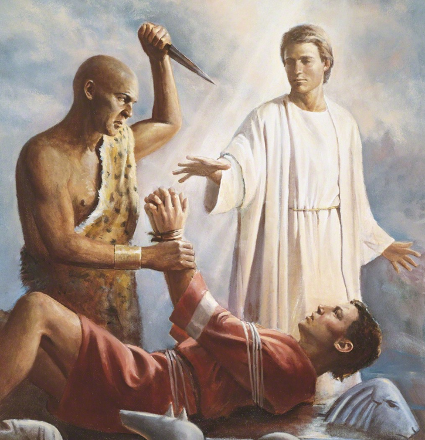Book of Abraham Insight #2
The Book of Abraham begins with an account of the biblical patriarch Abraham almost being sacrificed to “dumb idols” and “strange gods” (Abraham 1:7–8). The form of sacrifice practiced by Abraham’s kinsmen in Ur (vv. 8, 13) was said to be “after the manner of the Egyptians” (vv. 9, 11), and indeed a “priest of Pharaoh” was involved in this procedure (vv. 7–8, 10). This suggests that Abraham’s kinsmen had adopted elements of Egyptian practice and incorporated these elements into their local (Chaldean) practice.
This raises the question of whether the ancient Egyptians ever practiced “human sacrifice.”1 While scholars might disagree on what precise terminology to use, there is, in the words of one Egyptologist, “indisputable evidence for the practice of human sacrifice in classical ancient Egypt.”2 Some of the evidence for this practice dates to the likely time of Abraham (circa 2,000–1,800 BC). “The story presented in the Book of Abraham matches remarkably well with the picture of ritual slaying” in Egypt during the same time period, concludes two Egyptologists in a study of this evidence.3
For example, a stone inscription from the eighteenth-century BC decrees that anyone trespassing sacred space reserved only for priests would be burned. This indicates a cultural setting or “milieu in which slaying someone for desecration of sacred space was an accepted practice.”4 A royal inscription from two centuries earlier depicts the Egyptian king as decreeing death upon “children of the enemy” for desecrating a temple. This apparently included punishment by flaying, impalement, beheading, and burning. “[W]hen the sacred house of a god had been desecrated, the Egyptian king responded by sacrificing those responsible.”5
There is also direct archaeological evidence for “human sacrifice” or ritual slaying at an Egyptian fortress at the site of Mirgissa in modern northern Sudan. During the time of Abraham, this site was part of the Egyptian empire and was under Egyptian control. Discovered at the site was “a deposit . . . containing various ritual objects such as melted wax figurines, a flint knife, and the decapitated body of a foreigner slain during rites designed to ward off enemies. Almost universally, this discovery has been accepted as a case of human sacrifice.”6
This view is supported by so-called execration texts, or magical spells used to ward off evil and curse enemies by destroying a wax or clay human effigy (comparable to a voodoo doll).7 It would appear from the evidence uncovered at Mirgissa that on some occasions these magical rituals were performed on actual humans (as opposed to figurines), such as foreigners who were seen as a threat to Egyptian political and social order.8
From this evidence, we can conclude the following about Egyptian “human sacrifice” during Abraham’s lifetime:
- That it was more or less “ritual” in nature.
- That it was sometimes undertaken “for cultic offenses” or offenses against Egypt’s gods.
- That “the pharaoh [was sometimes] involved and the sacrifice [was sometimes] under his orders.”
- That sometimes these sacrifices were initiated “for rebellion against the pharaoh.”
- That “the sacrifice could take place both in Egypt proper and outside the boundaries in areas under Egyptian influence.” 9
These details converge remarkably well with the Book of Abraham, offering a plausible historical context for Abraham’s near-sacrifice.
Further Reading
Kerry Muhlestein, “Sacred Violence: When Ancient Egyptian Punishment was Dressed in Ritual Trappings,” Near Eastern Archaeology, 78, no. 4 (2015): 229–235.
Kerry Muhlestein and John Gee, “An Egyptian Context for the Sacrifice of Abraham,” Journal of the Book of Mormon and Other Restoration Scripture 20, no. 2 (2011): 70–77.
Footnotes
1 Past studies have looked at the practice of “human sacrifice” among Mesopotamian and Levantine peoples and the implications for the Book of Abraham. See William James Adams Jr., “Human Sacrifice and the Book of Abraham,” BYU Studies 9, no. 4 (1969): 473–480; Kevin Barney, “On Elkenah as Canaanite El,” Journal of the Book of Mormon and Other Restoration Scripture 19, no. 1 (2010): 29–30. See also the discussion in Beate Pongratz-Leisten, “Ritual Killing and Sacrifice in the Ancient Near East,” in Human Sacrifice in Jewish and Christian Tradition, ed. Karin Finsterbusch, Armin Lange, and K. F. Diethard Römheld (Leiden: Brill, 2007), 3–33.
2 Robert K. Ritner, The Mechanics of Ancient Egyptian Magical Practice (Chicago, Ill.: Oriental Institute, 1993), 162–63. Egyptologists typically use phrases such as “sacred violence,” “ritual slaying,” “sanctioned killing,” “capital punishment” and the like to avoid the pejorative connotations that arise with the term “human sacrifice.” Whatever it’s called, the practice documented among the ancient Egyptians ultimately involved putting humans to death for transgressing religious and/or political boundaries, sometimes done in a ritualistic or ceremonial manner. See the discussion in Kerry Muhlestein, Violence in the Service of Order: The Religious Framework for Sanctioned Killing in Ancient Egypt (Oxford: Archaeopress, 2011), 5–8; Herman te Velde, “Human Sacrifice in Ancient Egypt,” in The Strange World of Human Sacrifice, ed. Jan N. Bremmer (Leuven: Peeters, 2007), 127–134.
3 Kerry Muhlestein and John Gee, “An Egyptian Context for the Sacrifice of Abraham,” Journal of the Book of Mormon and Other Restoration Scripture 20, no. 2 (2011): 72.
4 Muhlestein and Gee, “An Egyptian Context for the Sacrifice of Abraham,” 73. Compare Harco Willems, “Crime, Cult and Capital Punishment (Mo‛alla Inscription 8),” The Journal of Egyptian Archaeology 76 (1990): 27–54.
5 Muhlestein and Gee, “An Egyptian Context for the Sacrifice of Abraham,” 73.
6 Muhlestein and Gee, “An Egyptian Context for the Sacrifice of Abraham,” 73.
7 See Kerry Muhlestein, “Execration Ritual,” in UCLA Encyclopedia of Egyptology, online at www.escholarship.org.
8 Muhlestein and Gee, “An Egyptian Context for the Sacrifice of Abraham,” 74; Velde, “Human Sacrifice in Ancient Egypt,” 131–132.
9 Muhlestein and Gee, “An Egyptian Context for the Sacrifice of Abraham,” 74.

